中国文化中英文对照
中国传统文化简介(中英文并存)

Mr Meilanfang increases international communication between China and other countries as the forerunner who spreads Beijing opera abroad. He has visited Japan in 1919, 1924 and 1956. In 1930, he visited America. He visited Russia in 1935 and 1952, which gained him a high reputation. During this period he knew many famous artists, singers, dancers, writers and painters. Because of his travels, there was an improved culture understanding in many countries. From that time forward, Beijing opera is listed into the dictionary of international drama. Mr Meilanfang is the symbol of Chinese acting art and holds with him our pride.
李小龙简介 李小龙英文简介 李小龙传奇简介 姓名:李小龙 妮称:细凤 英文 名字:Bruce lee 生日:1940年11月27日;籍贯:广东顺德;星座:射手座; 身高:173CM;体重:65KG;血型:O;学历:西雅图华盛顿州立大学;婚 姻状况:已婚;讨厌的地方:虚伪的社交场合;常到的地方:健身房,图书 馆,公园;最喜欢的运动:技击术;最喜欢的动物:狗;最喜爱的国家:中 国;嗜好:练武,冥想,跳舞,阅读;优点:正直善良,智慧超群;缺点: 至今没发现;其它:妻子:琳达;儿子:李国豪;女儿:李香凝;个人座右 铭:以无法为有法,以无限为有限;最喜欢的歌曲:《当我死去时》李小龙 葬礼上就播了此曲,天妒英才,悲哉! 六十年代后期,李小龙回香港发展电 影事业,先后主演了《唐山大兄》、《精武门》、《龙争虎斗》、《猛龙过 江》等电影,引起世界轰动;最后一部电影是《死亡游戏》。1973年7月20 日因病逝世。李小龙的逝世,不仅是武术界的损失,而且是电影界的损失。 遗着有《截拳道》、《功夫纪录》、《双节棍法》、《截拳道研究》。世界 各地成立了李小龙学会,研究李小龙的武术造诣。 1999年李小龙获《时代》 杂志评为“二十世纪的英雄与偶像”。他一生短暂、充满传奇,功夫盖世、 流芳千秋! 李小龙的一生是短暂的,但却如同一颗耀眼的彗星划过国际武坛 的上空,对现代技击术和电影表演艺术的发展作出了巨大的贡献。他主演的 功夫片风行海外,中国功夫也随之闻名于世界。许多外文字典和词典里都出 现了一个新词:“功夫”。在不少外国人心目中的功夫就是中国武术,李小 龙也成了功夫的化身 。
中国文化(中英文对照)
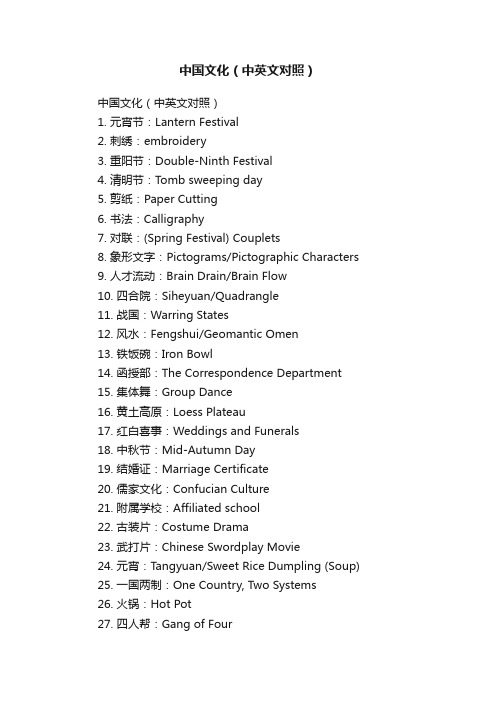
中国文化(中英文对照)中国文化(中英文对照)1. 元宵节:Lantern Festival2. 刺绣:embroidery3. 重阳节:Double-Ninth Festival4. 清明节:Tomb sweeping day5. 剪纸:Paper Cutting6. 书法:Calligraphy7. 对联:(Spring Festival) Couplets8. 象形文字:Pictograms/Pictographic Characters9. 人才流动:Brain Drain/Brain Flow10. 四合院:Siheyuan/Quadrangle11. 战国:Warring States12. 风水:Fengshui/Geomantic Omen13. 铁饭碗:Iron Bowl14. 函授部:The Correspondence Department15. 集体舞:Group Dance16. 黄土高原:Loess Plateau17. 红白喜事:Weddings and Funerals18. 中秋节:Mid-Autumn Day19. 结婚证:Marriage Certificate20. 儒家文化:Confucian Culture21. 附属学校:Affiliated school22. 古装片:Costume Drama23. 武打片:Chinese Swordplay Movie24. 元宵:Tangyuan/Sweet Rice Dumpling (Soup)25. 一国两制:One Country, Two Systems26. 火锅:Hot Pot27. 四人帮:Gang of Four28. 《诗经》:The Book of Songs29. 素质教育:Essential-qualities-oriented Education30. 《史记》:Historical Records/Records of the Grand Historian31. 大跃进:Great Leap Forward (Movement)32. 《西游记》:The Journey to the West33. 除夕:Chinese New Year’s Eve/Eve of the Spring Festival34. 针灸:Acupuncture35. 唐三彩:Tri-color Pottery of the T ang Dynasty/ The Tang Tri-colored pottery36. 中国特色的社会主义:Chinese-charactered Socialist/Socialist with Chinese characteristics37. 偏旁:radical38. 孟子:Mencius39. 亭/阁:Pavilion/ Attic40. 大中型国有企业:Large and Medium-sized State-owned Enterprises41. 火药:gunpowder42. 农历:Lunar Calendar43. 印/玺:Seal/Stamp44. 物质精神文明建设:The Construction of Material Civilization and Spiritual Civilization45. 京剧:Beijing Opera/Peking Opera46. 秦腔:Crying of Qin People/Qin Opera47. 太极拳:Tai Chi48. 独生子女证:The Certificate of One-child49. 天坛:Altar of Heaven in Beijing50. 小吃摊:Snack Bar/Snack Stand51. 红双喜:Double Happiness52. 政治辅导员:Political Counselor/School Counselor53. 春卷:Spring Roll(s)54. 莲藕:Lotus Root55. 追星族:Star Struck56. 故宫博物院:The Palace Museum57. 相声:Cross-talk/Comic Dialogue58. 下岗:Lay off/Laid off59. 北京烤鸭:Beijing Roast Duck60. 高等自学考试:Self-taught Examination of Higher Education61. 烟花爆竹:fireworks and firecracker62. 敦煌莫高窟:Mogao Caves63. 电视小品:TV Sketch/TV Skit64. 香港澳门同胞:Compatriots from Hong Kong and Macao65. 文化大革命:Cultural Revolution66. 长江中下游地区:The Mid-low Reaches of Yangtze River67. 门当户对:Perfect Match/Exact Match68. 《水浒》:Water Margin/Outlaws of the Marsh69. 中外合资企业:Joint Ventures70. 文房四宝(笔墨纸砚):"The Four Treasure of the Study" "Brush, Inkstick, Paper, and Inkstone"71. 兵马俑:cotta Warriors/ Terracotta Army72. 旗袍:cheongsam。
中国文化常识中英文对照18页word文档
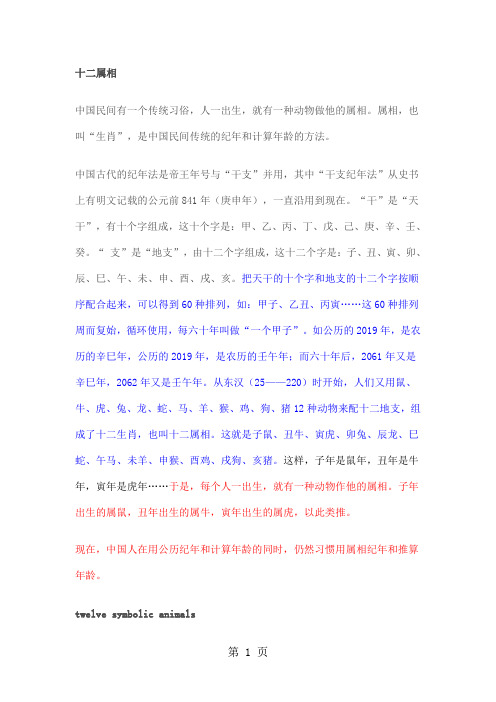
十二属相中国民间有一个传统习俗,人一出生,就有一种动物做他的属相。
属相,也叫“生肖”,是中国民间传统的纪年和计算年龄的方法。
中国古代的纪年法是帝王年号与“干支”并用,其中“干支纪年法”从史书上有明文记载的公元前841年(庚申年),一直沿用到现在。
“干”是“天干”,有十个字组成,这十个字是:甲、乙、丙、丁、戊、己、庚、辛、壬、癸。
“支”是“地支”,由十二个字组成,这十二个字是:子、丑、寅、卯、辰、巳、午、未、申、酉、戌、亥。
把天干的十个字和地支的十二个字按顺序配合起来,可以得到60种排列,如:甲子、乙丑、丙寅……这60种排列周而复始,循环使用,每六十年叫做“一个甲子”。
如公历的2019年,是农历的辛巳年,公历的2019年,是农历的壬午年;而六十年后,2061年又是辛巳年,2062年又是壬午年。
从东汉(25——220)时开始,人们又用鼠、牛、虎、兔、龙、蛇、马、羊、猴、鸡、狗、猪12种动物来配十二地支,组成了十二生肖,也叫十二属相。
这就是子鼠、丑牛、寅虎、卯兔、辰龙、巳蛇、午马、未羊、申猴、酉鸡、戌狗、亥猪。
这样,子年是鼠年,丑年是牛年,寅年是虎年……于是,每个人一出生,就有一种动物作他的属相。
子年出生的属鼠,丑年出生的属牛,寅年出生的属虎,以此类推。
现在,中国人在用公历纪年和计算年龄的同时,仍然习惯用属相纪年和推算年龄。
twelve symbolic animalsit is traditional in China,when a perpon is born,oneanimal(shuxiang)is used to symbolize this year.Shuxiang,also called shengxiao(any ofthe 12 animals representing the Earthly Branches),is a traditional way in China to number the years and to record a person's age.The ancient Chinese people invented the method to designate the years by the Heavenly Stems consist of thecharacters:jia,yi,bing,ding,wu,ji,geng,xin,ren,and gui.And the Earthly Branches are composed of 12characters:zi,shu,yin,mao,chen,si,wu,wei,shen,you,xu,hai bining each of the 10 Heavenly Stems with one of the 12 Earthly Branches in sequence creates 60 chronological symbols.For example jiazi,yichou,bingyin,etc.These 60 symbols are used in circles and thus each year has a chronological symbol.For example,2019 corresponds to xinsi,2019 to renwu in the lunar calendar;after 60 years,2061,once again,corresponds to xinsi,and 2062,to ter,people used 12 animalsto correspond to the 12 Earthly Branches,formingthe 12Symbolic Animals,namely Earthly Branch One Rat,Earthly Branch Two Ox,Earthly Branch Three Tiger,Earthly Branch Four Rabbit,Earthly Branch FiveDragon,Earthly Branch Six Snake,Earthly Branch Seven Horse,Earthly Branch Eight Sheep,Earthly Branch Nine Monkey,Earthly Branch Ten Rooster,Earthly Branch Eleven Dog,Earthly Branch Twelve Pig.Thus the zi year is the Year of the Rat,and the chou Year is the year of the Ox,and the yin Year is the Year of the Year of Tiger,etc.Therefore,when a person is born,he has an animal as his aymbolic animal.The year 2019 was a renwu year under lunar calendar,also the year of Horse,and so children born in this yea are all Horse babies.Even though the Chinese people now number the years and their age under the Gregorian calendar,the still continue to use the symbolic animals.As long as people know a person' probable age and his symbolic animao,people can infer his exact age and year of birth.小孩儿满月与抓周在中国,小孩儿的满月酒和抓周仪式独具特色。
中国文化 中英文对照
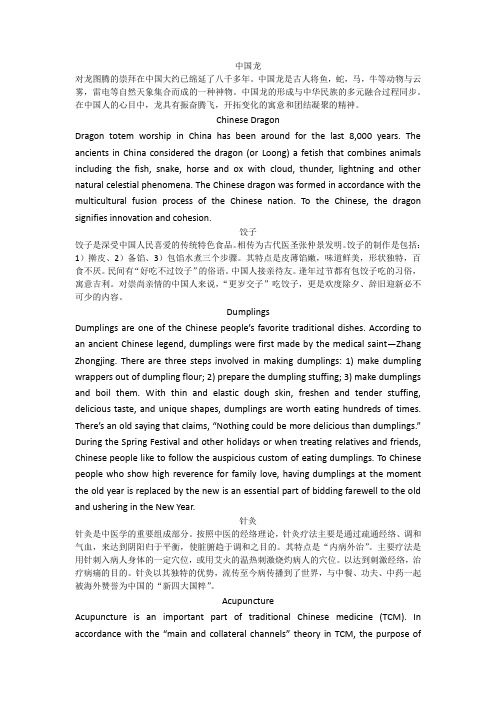
中国龙对龙图腾的崇拜在中国大约已绵延了八千多年。
中国龙是古人将鱼,蛇,马,牛等动物与云雾,雷电等自然天象集合而成的一种神物。
中国龙的形成与中华民族的多元融合过程同步。
在中国人的心目中,龙具有振奋腾飞,开拓变化的寓意和团结凝聚的精神。
Chinese DragonDragon totem worship in China has been around for the last 8,000 years. The ancients in China considered the dragon (or Loong) a fetish that combines animals including the fish, snake, horse and ox with cloud, thunder, lightning and other natural celestial phenomena. The Chinese dragon was formed in accordance with the multicultural fusion process of the Chinese nation. To the Chinese, the dragon signifies innovation and cohesion.饺子饺子是深受中国人民喜爱的传统特色食品。
相传为古代医圣张仲景发明。
饺子的制作是包括:1)擀皮、2)备馅、3)包馅水煮三个步骤。
其特点是皮薄馅嫩,味道鲜美,形状独特,百食不厌。
民间有“好吃不过饺子”的俗语。
中国人接亲待友。
逢年过节都有包饺子吃的习俗,寓意吉利。
对崇尚亲情的中国人来说,“更岁交子”吃饺子,更是欢度除夕、辞旧迎新必不可少的内容。
DumplingsDumplings are one of the Chinese people’s favorite traditional dishes. According to an ancient Chinese legend, dumplings were first made by the medical saint—Zhang Zhongjing. There are three steps involved in making dumplings: 1) make dumpling wrappers out of dumpling flour; 2) prepare the dumpling stuffing; 3) make dumplings and boil them. With thin and elastic dough skin, freshen and tender stuffing, delicious taste, and unique shapes, dumplings are worth eating hundreds of times. There’s an old saying that claims, “Nothing could be more delicious than dumplings.”During the Spring Festival and other holidays or when treating relatives and friends, Chinese people like to follow the auspicious custom of eating dumplings. To Chinese people who show high reverence for family love, having dumplings at the moment the old year is replaced by the new is an essential part of bidding farewell to the old and ushering in the New Year.针灸针灸是中医学的重要组成部分。
中国传统节日中英文对照
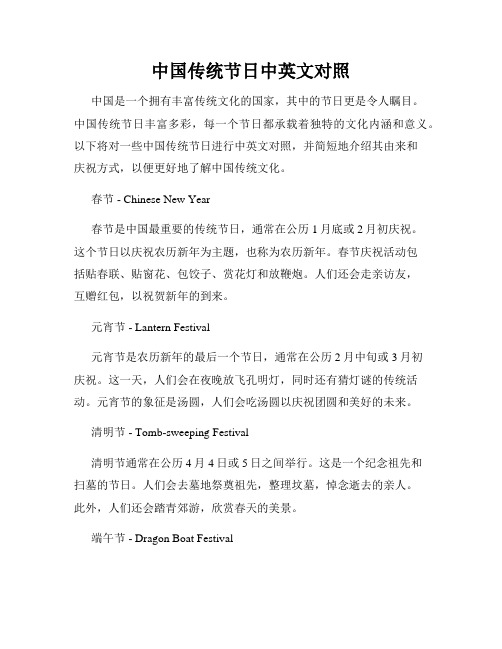
中国传统节日中英文对照中国是一个拥有丰富传统文化的国家,其中的节日更是令人瞩目。
中国传统节日丰富多彩,每一个节日都承载着独特的文化内涵和意义。
以下将对一些中国传统节日进行中英文对照,并简短地介绍其由来和庆祝方式,以便更好地了解中国传统文化。
春节 - Chinese New Year春节是中国最重要的传统节日,通常在公历1月底或2月初庆祝。
这个节日以庆祝农历新年为主题,也称为农历新年。
春节庆祝活动包括贴春联、贴窗花、包饺子、赏花灯和放鞭炮。
人们还会走亲访友,互赠红包,以祝贺新年的到来。
元宵节 - Lantern Festival元宵节是农历新年的最后一个节日,通常在公历2月中旬或3月初庆祝。
这一天,人们会在夜晚放飞孔明灯,同时还有猜灯谜的传统活动。
元宵节的象征是汤圆,人们会吃汤圆以庆祝团圆和美好的未来。
清明节 - Tomb-sweeping Festival清明节通常在公历4月4日或5日之间举行。
这是一个纪念祖先和扫墓的节日。
人们会去墓地祭奠祖先,整理坟墓,悼念逝去的亲人。
此外,人们还会踏青郊游,欣赏春天的美景。
端午节 - Dragon Boat Festival端午节是一个具有悠久历史的节日,通常在公历6月初庆祝。
这个节日源于纪念古代爱国诗人屈原,也是一项庆祝夏天到来的活动。
人们会参加龙舟赛、包粽子和挂艾草。
象征食物是粽子,人们吃粽子以保护自己免受邪恶和疾病的侵袭。
中秋节 - Mid-Autumn Festival中秋节是农历八月十五,通常在公历9月底或10月初庆祝。
这个节日庆祝秋天的丰收和团圆。
人们会赏月、品尝月饼以及举办家庭聚会。
月饼是中秋节的特色食物,馅料的种类多样,寓意着团圆和祝福。
重阳节 - Double Ninth Festival重阳节通常在公历9月初或10月底庆祝,也被称为老人节。
此节日的由来与古代传说有关,人们会爬山、采菊、追溯阳光,并祝福年长的亲人和朋友。
重阳节也是缅怀祖先和尊重老年人的时间。
中国传统文化(中英文)
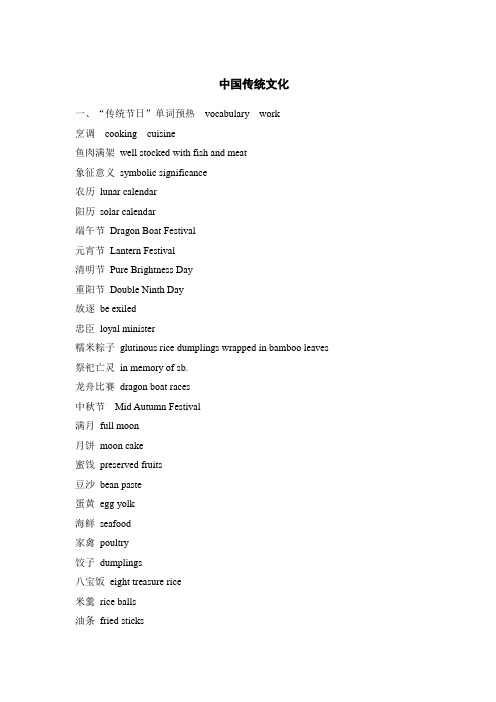
中国传统文化一、“传统节日”单词预热vocabulary work烹调cooking cuisine鱼肉满架well stocked with fish and meat象征意义symbolic significance农历lunar calendar阳历solar calendar端午节Dragon Boat Festival元宵节Lantern Festival清明节Pure Brightness Day重阳节Double Ninth Day放逐be exiled忠臣loyal minister糯米粽子glutinous rice dumplings wrapped in bamboo leaves 祭祀亡灵in memory of sb.龙舟比赛dragon boat races中秋节Mid Autumn Festival满月full moon月饼moon cake蜜饯preserved fruits豆沙bean paste蛋黄egg yolk海鲜seafood家禽poultry饺子dumplings八宝饭eight treasure rice米羹rice balls油条fried sticks麻花fried twisted stick炒面Chaomian叉烧包steamed bun with roast pork粥porridge芋头taro葱油饼pan-fried cake with sesame seeds and green onion有关春节的常用词放鞭炮let off firecrackers耍龙灯play the dragon lantern耍狮子play the lion dance拜年pay a new-year callChinese to English:1. 玉器是光辉灿烂的中华民族历史文化宝库中一枝异彩独放的奇葩。
中国玉器在新石器时代的河姆渡文化时期就开始出现。
7000年来一直延续不断,发展至今。
中国文化英文故事
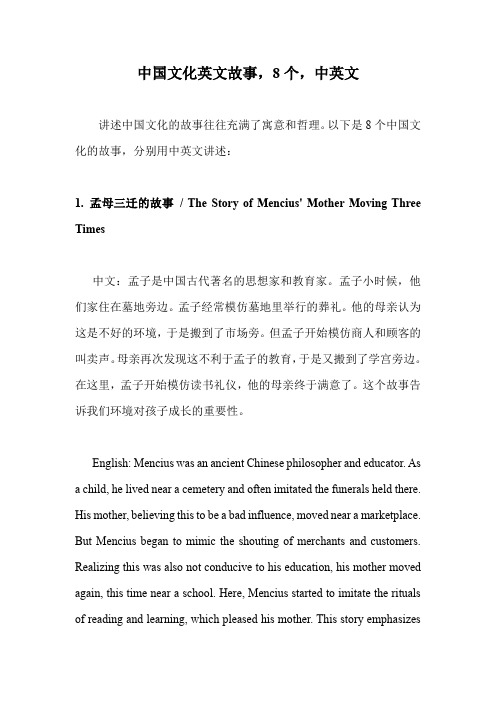
中国文化英文故事,8个,中英文讲述中国文化的故事往往充满了寓意和哲理。
以下是8个中国文化的故事,分别用中英文讲述:1. 孟母三迁的故事/ The Story of Mencius' Mother Moving Three Times中文:孟子是中国古代著名的思想家和教育家。
孟子小时候,他们家住在墓地旁边。
孟子经常模仿墓地里举行的葬礼。
他的母亲认为这是不好的环境,于是搬到了市场旁。
但孟子开始模仿商人和顾客的叫卖声。
母亲再次发现这不利于孟子的教育,于是又搬到了学宫旁边。
在这里,孟子开始模仿读书礼仪,他的母亲终于满意了。
这个故事告诉我们环境对孩子成长的重要性。
English: Mencius was an ancient Chinese philosopher and educator. As a child, he lived near a cemetery and often imitated the funerals held there. His mother, believing this to be a bad influence, moved near a marketplace. But Mencius began to mimic the shouting of merchants and customers. Realizing this was also not conducive to his education, his mother moved again, this time near a school. Here, Mencius started to imitate the rituals of reading and learning, which pleased his mother. This story emphasizesthe importance of the right environment for a child's growth.2. 守株待兔的故事/ The Story of the Man Who Waited for a Rabbit中文:这个故事讲的是一个农民在田里工作时,偶然有只兔子撞在树根上死了。
中国传统文化(中英文)

中国传统文化一、“传统节日”单词预热vocabulary work烹调cooking cuisine鱼肉满架well stocked with fish and meat象征意义symbolic significance农历lunar calendar阳历solar calendar端午节Dragon Boat Festival元宵节Lantern Festival清明节Pure Brightness Day重阳节Double Ninth Day放逐be exiled忠臣loyal minister糯米粽子glutinous rice dumplings wrapped in bamboo leaves 祭祀亡灵in memory of sb.龙舟比赛dragon boat races中秋节Mid Autumn Festival满月full moon月饼moon cake蜜饯preserved fruits豆沙bean paste蛋黄egg yolk海鲜seafood家禽poultry饺子dumplings八宝饭eight treasure rice米羹rice balls油条fried sticks麻花fried twisted stick炒面Chaomian叉烧包steamed bun with roast pork粥porridge芋头taro葱油饼pan-fried cake with sesame seeds and green onion有关春节的常用词放鞭炮let off firecrackers耍龙灯play the dragon lantern耍狮子play the lion dance拜年pay a new-year call三、实考题分析中国的传统节庆膳食除了在数量和质量上与平时有所不同之外,一些历史悠久、具有象征意义的食物也是节日必不可缺的伴侣。
Traditional holiday meals are different from everyday meals in terms of quantity and quality. In addition, some foods with a long history and symbolic significance are indispensable on these occasions.例如,我国的端午节是纪念古代诗人屈原的日子。
英语四级中国传统文化的单词
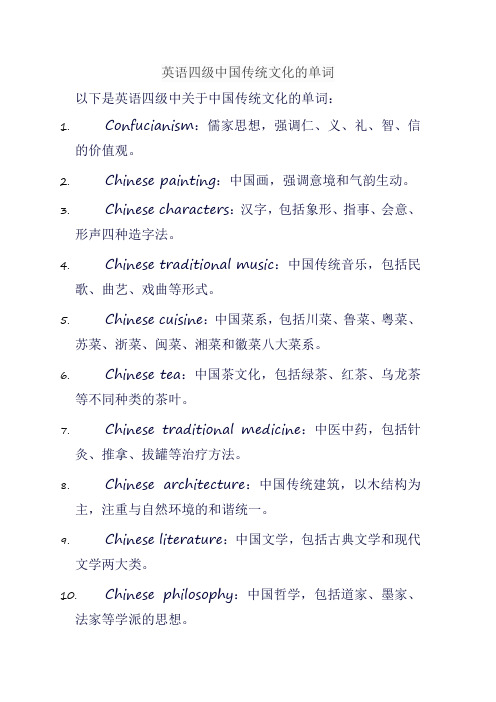
英语四级中国传统文化的单词
以下是英语四级中关于中国传统文化的单词:
1.Confucianism:儒家思想,强调仁、义、礼、智、信
的价值观。
2.Chinese painting:中国画,强调意境和气韵生动。
3.Chinese characters:汉字,包括象形、指事、会意、
形声四种造字法。
4.Chinese traditional music:中国传统音乐,包括民
歌、曲艺、戏曲等形式。
5.Chinese cuisine:中国菜系,包括川菜、鲁菜、粤菜、
苏菜、浙菜、闽菜、湘菜和徽菜八大菜系。
6.Chinese tea:中国茶文化,包括绿茶、红茶、乌龙茶
等不同种类的茶叶。
7.Chinese traditional medicine:中医中药,包括针
灸、推拿、拔罐等治疗方法。
8.Chinese architecture:中国传统建筑,以木结构为
主,注重与自然环境的和谐统一。
9.Chinese literature:中国文学,包括古典文学和现代
文学两大类。
10.Chinese philosophy:中国哲学,包括道家、墨家、
法家等学派的思想。
这些单词可以用于描述中国传统文化的内容和特点,帮助您更好地了解和掌握相关的英语表达方式。
中国传统文化(中英文)

中国传统文化一、“传统节日”单词预热vocabulary work烹调cooking cuisine鱼肉满架well stocked with fish and meat象征意义symbolic significance农历lunar calendar阳历solar calendar端午节Dragon Boat Festival元宵节Lantern Festival清明节Pure Brightness Day重阳节Double Ninth Day放逐be exiled忠臣loyal minister糯米粽子glutinous rice dumplings wrapped in bamboo leaves 祭祀亡灵in memory of sb.龙舟比赛dragon boat races中秋节Mid Autumn Festival满月full moon月饼moon cake蜜饯preserved fruits豆沙bean paste蛋黄egg yolk海鲜seafood家禽poultry饺子dumplings八宝饭eight treasure rice米羹rice balls油条fried sticks麻花fried twisted stick炒面Chaomian叉烧包steamed bun with roast pork粥porridge芋头taro葱油饼pan-fried cake with sesame seeds and green onion有关春节的常用词放鞭炮let off firecrackers耍龙灯play the dragon lantern耍狮子play the lion dance拜年pay a new-year call二、有关“介绍”的翻译•我很高兴向各位介绍中国的主要传统节日。
→I am very happy to have the opportunity to talk to you about major traditional Chinese holidays.表示“介绍情况”时,我们可以这样翻译:1.to share with you brief information•在此,我愿意向朋友们介绍这些方面的情况。
中国文化博大精深英语作文
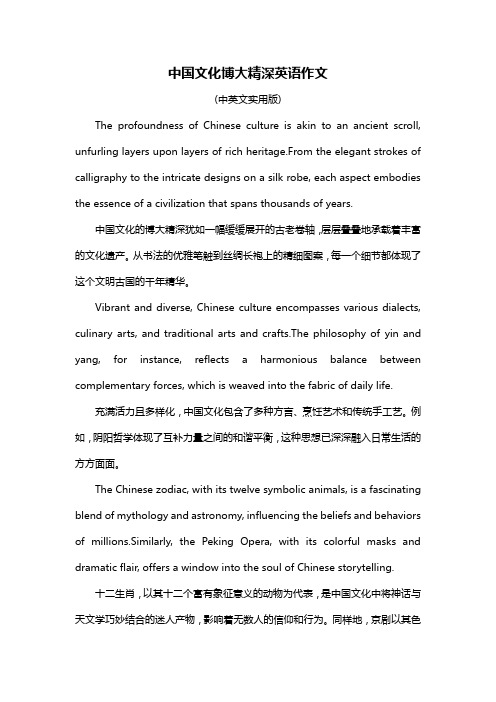
中国文化博大精深英语作文(中英文实用版)The profoundness of Chinese culture is akin to an ancient scroll, unfurling layers upon layers of rich heritage.From the elegant strokes of calligraphy to the intricate designs on a silk robe, each aspect embodies the essence of a civilization that spans thousands of years.中国文化的博大精深犹如一幅缓缓展开的古老卷轴,层层叠叠地承载着丰富的文化遗产。
从书法的优雅笔触到丝绸长袍上的精细图案,每一个细节都体现了这个文明古国的千年精华。
Vibrant and diverse, Chinese culture encompasses various dialects, culinary arts, and traditional arts and crafts.The philosophy of yin and yang, for instance, reflects a harmonious balance between complementary forces, which is weaved into the fabric of daily life.充满活力且多样化,中国文化包含了多种方言、烹饪艺术和传统手工艺。
例如,阴阳哲学体现了互补力量之间的和谐平衡,这种思想已深深融入日常生活的方方面面。
The Chinese zodiac, with its twelve symbolic animals, is a fascinating blend of mythology and astronomy, influencing the beliefs and behaviors of millions.Similarly, the Peking Opera, with its colorful masks and dramatic flair, offers a window into the soul of Chinese storytelling.十二生肖,以其十二个富有象征意义的动物为代表,是中国文化中将神话与天文学巧妙结合的迷人产物,影响着无数人的信仰和行为。
中国传统文化中英对照
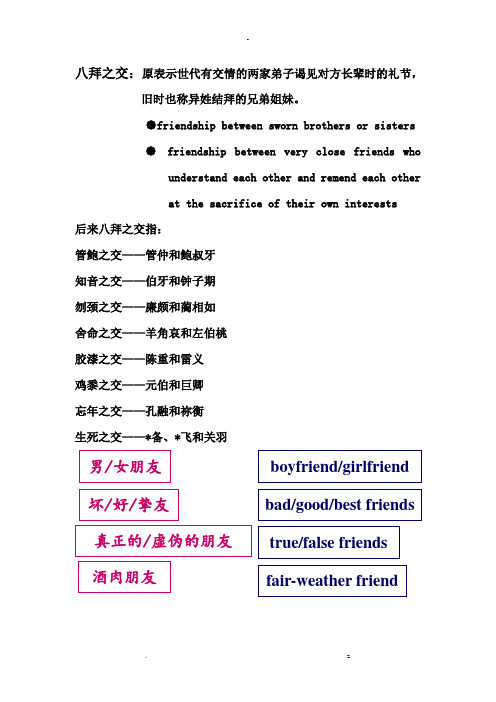
八拜之交:原表示世代有交情的两家弟子谒见对方长辈时的礼节,旧时也称异姓结拜的兄弟姐妹。
●friendship between sworn brothers or sisters●friendship between very close friends whounderstand each other and remend each otherat the sacrifice of their own interests莫逆之交:bosom friends总角之交:friendship between people who are friends since childhood一般作宾语,指儿时的朋友。
总角:古代未成年的人把头发扎成髻。
借指童年时期,幼年。
总角是八九岁至十三四岁的少年,古代儿童将头发分作左右两半,在头顶各扎成一个结,形如两个羊角,故称“总角〞。
贫贱之交:friendship between people who are poverty-stricken and from humble circumstances杵臼之交:friendship between people who do not care about the financial condition and social status of each other 杵:舂米的木棒;臼:石臼。
比喻交朋友不计较贫富和身分。
君子之交:friendship between gentlemen小人之交:friendship between villains狐朋狗友:people who often gather together doing something meaningless and even illegal棋友/牌友/球友:people who often meet to play chess, poker, ball. etc.战友:people who get to know each other while serving in the same army unit普通老百姓交的朋友谓“布衣之交〞;有钱人与没钱人交朋友谓“车笠之交〞;在逆境中结交的朋友称“患难之交〞;吃喝玩乐结交的朋友称“酒肉之交〞;年岁差异大,行辈不同而交情深厚的朋友称“忘年之交〞;幼年相交的朋友称“竹马之交〞;交情深厚的朋友谓“肺腑之交〞;亲密无间的朋友谓“胶漆之交〞;生死与共的朋友谓“生死之交〞;情投意合的朋友称“莫逆之交〞;哪怕砍头也不改变友谊的朋友称“刎颈之交〞;无意中相遇而结成的朋友称“邂逅之交〞;在道义上互相支持的朋友称“君子之交〞;只见过一次面,交情不深的朋友称“一面之交〞;仅点头打招呼,感情不深的朋友称“点头之交〞;平淡而浮泛交往的朋友称“泛泛之交〞;见过面但不熟悉的人称“半面之交〞;旧时结拜的兄弟姊妹称“八拜之交〞;交友不嫌贫贱称“杵逆之交〞;珍贵而有价值的交往称“金玉之交〞。
中国文化概况英汉对照版
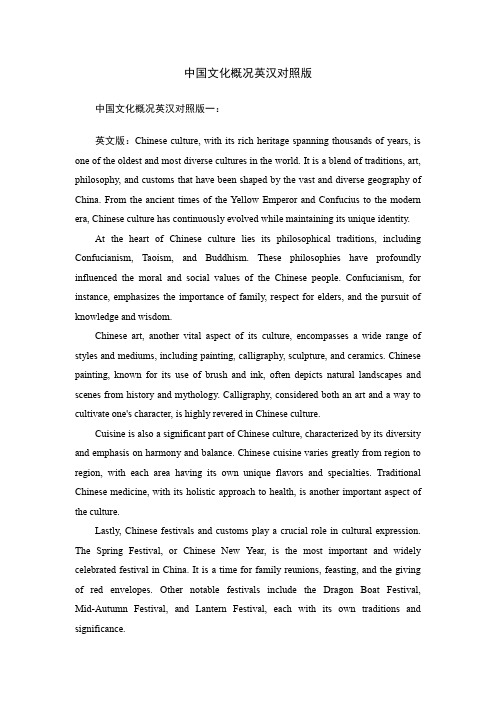
中国文化概况英汉对照版中国文化概况英汉对照版一:英文版:Chinese culture, with its rich heritage spanning thousands of years, is one of the oldest and most diverse cultures in the world. It is a blend of traditions, art, philosophy, and customs that have been shaped by the vast and diverse geography of China. From the ancient times of the Yellow Emperor and Confucius to the modern era, Chinese culture has continuously evolved while maintaining its unique identity.At the heart of Chinese culture lies its philosophical traditions, including Confucianism, Taoism, and Buddhism. These philosophies have profoundly influenced the moral and social values of the Chinese people. Confucianism, for instance, emphasizes the importance of family, respect for elders, and the pursuit of knowledge and wisdom.Chinese art, another vital aspect of its culture, encompasses a wide range of styles and mediums, including painting, calligraphy, sculpture, and ceramics. Chinese painting, known for its use of brush and ink, often depicts natural landscapes and scenes from history and mythology. Calligraphy, considered both an art and a way to cultivate one's character, is highly revered in Chinese culture.Cuisine is also a significant part of Chinese culture, characterized by its diversity and emphasis on harmony and balance. Chinese cuisine varies greatly from region to region, with each area having its own unique flavors and specialties. Traditional Chinese medicine, with its holistic approach to health, is another important aspect of the culture.Lastly, Chinese festivals and customs play a crucial role in cultural expression. The Spring Festival, or Chinese New Year, is the most important and widely celebrated festival in China. It is a time for family reunions, feasting, and the giving of red envelopes. Other notable festivals include the Dragon Boat Festival, Mid-Autumn Festival, and Lantern Festival, each with its own traditions and significance.汉语对照版:中国文化,拥有数千年的丰富遗产,是世界上最古老、最多样化的文化之一。
中国传统文化中英文翻译
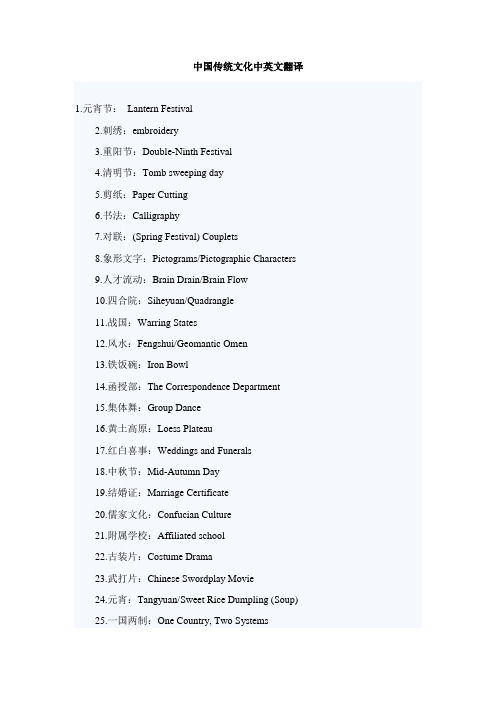
中国传统文化中英文翻译1.元宵节:Lantern Festival2.刺绣:embroidery3.重阳节:Double-Ninth Festival4.清明节:Tomb sweeping day5.剪纸:Paper Cutting6.书法:Calligraphy7.对联:(Spring Festival) Couplets8.象形文字:Pictograms/Pictographic Characters9.人才流动:Brain Drain/Brain Flow10.四合院:Siheyuan/Quadrangle11.战国:Warring States12.风水:Fengshui/Geomantic Omen13.铁饭碗:Iron Bowl14.函授部:The Correspondence Department15.集体舞:Group Dance16.黄土高原:Loess Plateau17.红白喜事:Weddings and Funerals18.中秋节:Mid-Autumn Day19.结婚证:Marriage Certificate20.儒家文化:Confucian Culture21.附属学校:Affiliated school22.古装片:Costume Drama23.武打片:Chinese Swordplay Movie24.元宵:Tangyuan/Sweet Rice Dumpling (Soup)25.一国两制:One Country, Two Systems26.火锅:Hot Pot27.四人帮:Gang of Four28.《诗经》:The Book of Songs29.素质教育:Essential-qualities-oriented Education30.《史记》:Historical Records/Records of the Grand Historian31.大跃进:Great Leap Forward (Movement)32.《西游记》:The Journey to the West33.除夕:Chinese New Year’s Eve/Eve of the Spring F estival34.针灸:Acupuncture35.唐三彩:Tri-color Pottery of the Tang Dynasty/ The Tang Tri-colored pottery36.中国特色的社会主义:Chinese-charactered Socialist/Socialist with Chinese characteristics37.偏旁:radical38.孟子:Mencius39.亭/阁:Pavilion/ Attic40.大中型国有企业:Large and Medium-sized State-owned Enterprises41.火药:gunpowder42.农历:Lunar Calendar43.印/玺:Seal/Stamp44.物质精神文明建设:The Construction of Material Civilization and Spiritual Civilization45.京剧:Beijing Opera/Peking Opera46.秦腔:Crying of Qin People/Qin Opera47.太极拳:Tai Chi48.独生子女证:The Certificate of One-child49.天坛:Altar of Heaven in Beijing50.小吃摊:Snack Bar/Snack Stand51.红双喜:Double Happiness52.政治辅导员:Political Counselor/School Counselor53.春卷:Spring Roll(s)54.莲藕:Lotus Root55.追星族:Star Struck56.故宫博物院:The Palace Museum57.相声:Cross-talk/Comic Dialogue58.下岗:Lay off/Laid off59.北京烤鸭:Beijing Roast Duck60.高等自学考试:Self-taught Examination of Higher Education61.烟花爆竹:fireworks and firecracker62.敦煌莫高窟:Mogao Caves63.电视小品:TV Sketch/TV Skit64.香港澳门同胞:Compatriots from Hong Kong and Macao65.文化大革命:Cultural Revolution66.长江中下游地区:The Mid-low Reaches of Yangtze River67.门当户对:Perfect Match/Exact Match68.《水浒》:Water Margin/Outlaws of the Marsh69.中外合资企业:Joint Ventures70.文房四宝(笔墨纸砚):"The Four Treasure of the Study" "Brush, Inkstick, Paper, and Inkstone"71.兵马俑:cotta Warriors/ Terracotta Army。
中国文化常识(中英文)
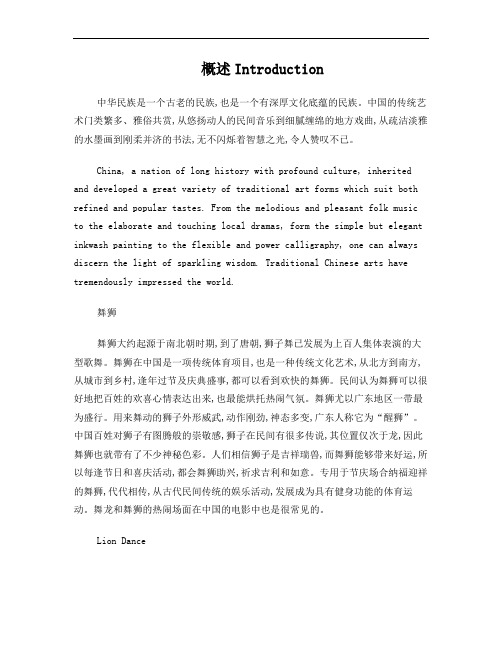
概述Introduction中华民族是一个古老的民族,也是一个有深厚文化底蕴的民族。
中国的传统艺术门类繁多、雅俗共赏,从悠扬动人的民间音乐到细腻缠绵的地方戏曲,从疏洁淡雅的水墨画到刚柔并济的书法,无不闪烁着智慧之光,令人赞叹不已。
China, a nation of long history with profound culture, inherited and developed a great variety of traditional art forms which suit both refined and popular tastes. From the melodious and pleasant folk music to the elaborate and touching local dramas, form the simple but elegant inkwash painting to the flexible and power calligraphy, one can always discern the light of sparkling wisdom. Traditional Chinese arts have tremendously impressed the world.舞狮舞狮大约起源于南北朝时期,到了唐朝,狮子舞已发展为上百人集体表演的大型歌舞。
舞狮在中国是一项传统体育项目,也是一种传统文化艺术,从北方到南方,从城市到乡村,逢年过节及庆典盛事,都可以看到欢快的舞狮。
民间认为舞狮可以很好地把百姓的欢喜心情表达出来,也最能烘托热闹气氛。
舞狮尤以广东地区一带最为盛行。
用来舞动的狮子外形威武,动作刚劲,神态多变,广东人称它为“醒狮”。
中国百姓对狮子有图腾般的崇敬感,狮子在民间有很多传说,其位置仅次于龙,因此舞狮也就带有了不少神秘色彩。
人们相信狮子是吉祥瑞兽,而舞狮能够带来好运,所以每逢节日和喜庆活动,都会舞狮助兴,祈求吉利和如意。
中国文化-Chinese Culture (中英文)
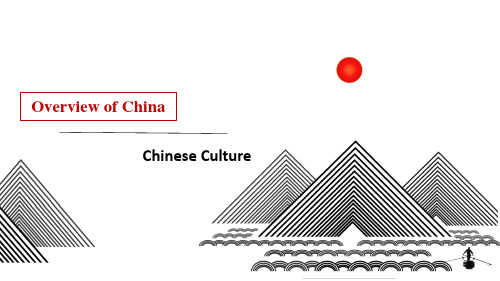
兰 有 秀 兮 菊 有 芳 ︐ 怀
草 木 黄 落 兮 雁 南 归 ︒
秋 风 起 兮 白 云 飞 ︐
单击此处添加标题
单击此处添加标题
单击此处添加标题
笔
画
Stroke
单击此处添加标题
单击此处添加标题
中 书
国 法
Calligraphy
单击此处添加标题
文房四宝
Four Treasures of the Study
单击此处添加标题
名
Given Nmae
单击此处添加标题
京 /jīng/
忠 /zhōng/
健 /jià n/
some names embody the location, time or natural phenomenon when the person was born.
冬 /dōng/
雪 /xuě/
With ancient official titles eventually adopted as the surname, such as Sima and Situ.
中 国 姓 氏
Chiense Surnames
单击此处添加标题
李 /lǐ/ 王 /wáng/ 张 /zhāng/
Some are one-character surnames, while others are compound surnames made up of two or more charaers. Up
Overview of China Chinese Culture
目 录
壹
中 国 人 的 姓 名
贰
中 国 汉 字
叁
中 国 传 统 节 日
中国文化常识(中英文)

概述Introduction中华民族是一个古老的民族,也是一个有深厚文化底蕴的民族。
中国的传统艺术门类繁多、雅俗共赏,从悠扬动人的民间音乐到细腻缠绵的地方戏曲,从疏洁淡雅的水墨画到刚柔并济的书法,无不闪烁着智慧之光,令人赞叹不已。
China, a nation of long history with profound culture, inherited and developed a great variety of traditional art forms which suit both refined and popular tastes. From the melodious and pleasant folk music to the elaborate and touching local dramas, form the simple but elegant inkwash painting to the flexible and power calligraphy, one can always discern the light of sparkling wisdom. Traditional Chinese arts have tremendously impressed the world.舞狮舞狮大约起源于南北朝时期,到了唐朝,狮子舞已发展为上百人集体表演的大型歌舞。
舞狮在中国是一项传统体育项目,也是一种传统文化艺术,从北方到南方,从城市到乡村,逢年过节及庆典盛事,都可以看到欢快的舞狮。
民间认为舞狮可以很好地把百姓的欢喜心情表达出来,也最能烘托热闹气氛。
舞狮尤以广东地区一带最为盛行。
用来舞动的狮子外形威武,动作刚劲,神态多变,广东人称它为“醒狮”。
中国百姓对狮子有图腾般的崇敬感,狮子在民间有很多传说,其位置仅次于龙,因此舞狮也就带有了不少神秘色彩。
人们相信狮子是吉祥瑞兽,而舞狮能够带来好运,所以每逢节日和喜庆活动,都会舞狮助兴,祈求吉利和如意。
中国文化英语作文初三
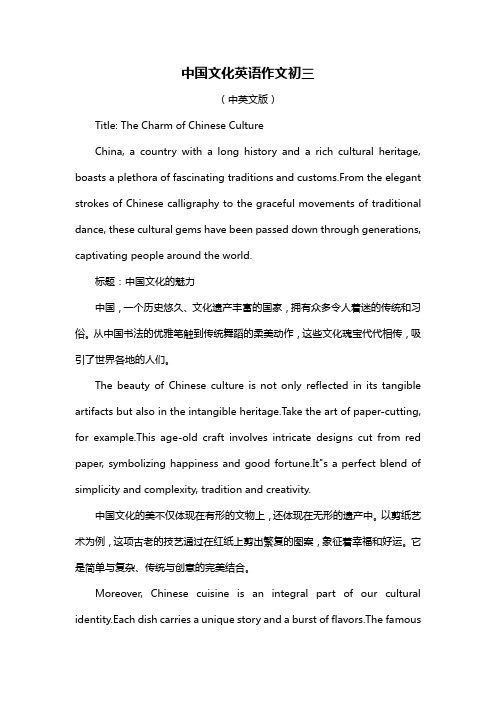
中国文化英语作文初三(中英文版)Title: The Charm of Chinese CultureChina, a country with a long history and a rich cultural heritage, boasts a plethora of fascinating traditions and customs.From the elegant strokes of Chinese calligraphy to the graceful movements of traditional dance, these cultural gems have been passed down through generations, captivating people around the world.标题:中国文化的魅力中国,一个历史悠久、文化遗产丰富的国家,拥有众多令人着迷的传统和习俗。
从中国书法的优雅笔触到传统舞蹈的柔美动作,这些文化瑰宝代代相传,吸引了世界各地的人们。
The beauty of Chinese culture is not only reflected in its tangible artifacts but also in the intangible heritage.Take the art of paper-cutting, for example.This age-old craft involves intricate designs cut from red paper, symbolizing happiness and good fortune.It"s a perfect blend of simplicity and complexity, tradition and creativity.中国文化的美不仅体现在有形的文物上,还体现在无形的遗产中。
《传统中国文化》小学英语作文
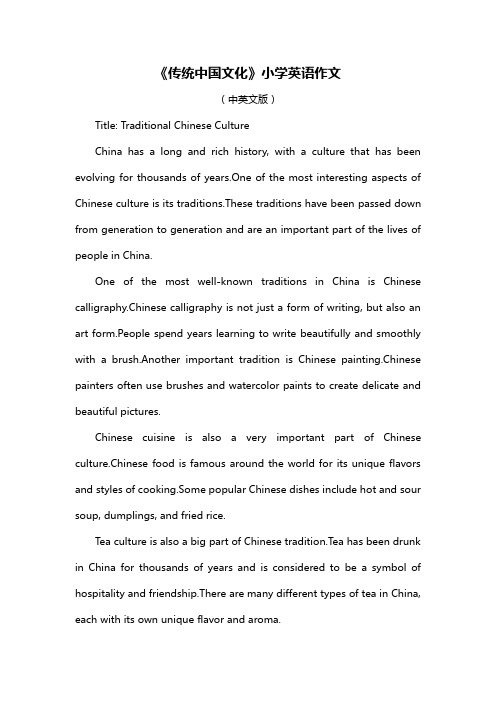
《传统中国文化》小学英语作文(中英文版)Title: Traditional Chinese CultureChina has a long and rich history, with a culture that has been evolving for thousands of years.One of the most interesting aspects of Chinese culture is its traditions.These traditions have been passed down from generation to generation and are an important part of the lives of people in China.One of the most well-known traditions in China is Chinese calligraphy.Chinese calligraphy is not just a form of writing, but also an art form.People spend years learning to write beautifully and smoothly with a brush.Another important tradition is Chinese painting.Chinese painters often use brushes and watercolor paints to create delicate and beautiful pictures.Chinese cuisine is also a very important part of Chinese culture.Chinese food is famous around the world for its unique flavors and styles of cooking.Some popular Chinese dishes include hot and sour soup, dumplings, and fried rice.Tea culture is also a big part of Chinese tradition.Tea has been drunk in China for thousands of years and is considered to be a symbol of hospitality and friendship.There are many different types of tea in China, each with its own unique flavor and aroma.Another important tradition in China is the Chinese calendar.The Chinese calendar is lunar-based and has been used for centuries to mark important events and festivals.Some of the most well-known Chinese festivals include the Spring Festival, also known as Chinese New Year, and the Mid-Autumn Festival.Chinese traditional clothing, or 'hanfu,' is also a symbol of Chinese culture.Hanfu has a long history and has been worn by people in China for thousands of years.It often features bright colors and intricate designs.In conclusion, Chinese traditional culture is a fascinating and complex system of customs, beliefs, and practices that have been passed down through the ages.From calligraphy and painting to cuisine and festivals, Chinese traditions are an important part of the country's identity and continue to be celebrated and cherished by people all over the world.。
- 1、下载文档前请自行甄别文档内容的完整性,平台不提供额外的编辑、内容补充、找答案等附加服务。
- 2、"仅部分预览"的文档,不可在线预览部分如存在完整性等问题,可反馈申请退款(可完整预览的文档不适用该条件!)。
- 3、如文档侵犯您的权益,请联系客服反馈,我们会尽快为您处理(人工客服工作时间:9:00-18:30)。
中国龙对龙图腾的崇拜在中国大约已绵延了八千多年。
中国龙是古人将鱼,蛇,马,牛等动物与云雾,雷电等自然天象集合而成的一种神物。
中国龙的形成与中华民族的多元融合过程同步。
在中国人的心目中,龙具有振奋腾飞,开拓变化的寓意和团结凝聚的精神。
Chinese DragonDragon totem worship in China has been around for the last 8,000 years. The ancients in China considered the dragon (or Loong) a fetish that combines animals including the fish, snake, horse and ox with cloud, thunder, lightning and other natural celestial phenomena. The Chinese dragon was formed in accordance with the multicultural fusion process of the Chinese nation. To the Chinese, the dragon signifies innovation and cohesion.饺子饺子是深受中国人民喜爱的传统特色食品。
相传为古代医圣仲景发明。
饺子的制作是包括:1)擀皮、2)备馅、3)包馅水煮三个步骤。
其特点是皮薄馅嫩,味道鲜美,形状独特,百食不厌。
民间有"好吃不过饺子"的俗语。
中国人接亲待友。
逢年过节都有包饺子吃的习俗,寓意吉利。
对崇尚亲情的中国人来说,"更岁交子"吃饺子,更是欢度除夕、辞旧迎新必不可少的容。
DumplingsDumplings are one of the Chinese people's favorite traditional dishes. According to an ancient Chinese legend, dumplings were first made by the medical saint-Zhang Zhongjing. There are three steps involved in making dumplings: 1) make dumpling wrappers out of dumpling flour; 2) prepare the dumpling stuffing; 3) make dumplings and boil them. With thin and elastic dough skin, freshen and tender stuffing, delicious taste, and unique shapes, dumplings are worth eating hundreds of times. There's an old saying that claims, "Nothing could be more delicious than dumplings." During the Spring Festival and other holidays or when treating relatives and friends, Chinese people like to follow the auspicious custom of eating dumplings. To Chinese people who show high reverence for family love, having dumplings at the moment the old year is replaced by the new is an essential part of bidding farewell to the old and ushering in the New Year.针灸针灸是中医学的重要组成部分。
按照中医的经络理论,针灸疗法主要是通过疏通经络、调和气血,来达到阴阳归于平衡,使脏腑趋于调和之目的。
其特点是"病外治"。
主要疗法是用针刺入病人身体的一定穴位,或用艾火的温热刺激烧灼病人的穴位。
以达到刺激经络,治疗病痛的目的。
针灸以其独特的优势,流传至今病传播到了世界,与中餐、功夫、中药一起被海外赞誉为中国的"新四大国粹"。
AcupunctureAcupuncture is an important part of traditional Chinese medicine (TCM). In accordance with the "main and collateral channels" theory in TCM, the purpose of acupuncture is to dredge the channel and regulate qi and blood, so as to keep the body's yin and yang balanced and achieve reconciliation between the internal organs. It features in traditional Chinese medicine that "internal diseases are to b e treated with external therapy"/ the main therapy of acupuncture involves using needles to pierce certain acupoints of the patient's body, or adopting moxibustion to stimulate the patient's acupoints so as to stimulate the channelsand relieve pain. With its unique advantages, acupuncture has been handed down generation after generation and has now spread all over the world. Nowadays, acupuncture, along with Chinese food, kungfu (otherwise known as Chinese martial arts), and traditional Chinese medicine, has been internationally hailed as one of the "four new national treasures".中国汉字汉字是从原始人用以记事的简单图画,经过不断演变发展最终成为一种兼具音、形、意、韵的独特文字。
现存中国古代最早成熟的文字是甲骨文,被认为是现代汉字的初形。
此后,汉字又经历了金文、隶书、楷书、草书、行书等不同的阶段。
汉字结构"圆外方",源于古人"天圆地方"的观念。
汉字有五种基本笔画,即:横、竖、撇、捺、折。
Chinese charactersChinese characters were initially meant to be simple pictures use to help people remember things. After a long period of development, it finally became a unique character system that embodies phonetic sound, image, idea, and rhyme at the same time. The writing system, which was extremely advanced in ancient times, began with inscriptions on bones and tortoise shells, and these are regarded as the original forms of Chinese characters. Afterwards, Chinese characters went through numerous calligraphic styles: bronze inscriptions, official script, regular script, cursive script, running script, etc. Chinese characters are usually round outside and square inside, which is rooted in ancient Chinese beliefs of an orbicular sky and a rectangular Earth. The five basic strokes of Chinese characters are " 一" (the horizontal stroke), " 丨" (the vertical stroke), "丿" (the left-falling stroke), " 捺" (the right-falling stroke), and "乙" (the turning stroke).中国筷子中国人使用筷子就餐的方式在世界独树一帜。
有史记载用筷的历史已有三千多年。
筷子古时称为箸,它看似简单,但却同时具有夹、拨、挑、扒、拌、撮、戳、撕等多种功能。
中国民间视筷子为吉祥之物,如婚俗中将筷子隐喻为快生贵子的祝福等。
与使用刀叉以及手抓的方式不同,成双结对的筷子含有"和为贵"的意蕴。
西方人赞誉筷子是古老的文明。
Chinese chopsticksThe Chinese way of eating with chopsticks is unique in the world. The recorded history of chopsticks started more than three thousand years ago. Chopsticks were named zhu in ancient Chinese. They look deceptively simple to use, but possess multi-various functions, such as clamping, turning over, lifting up, raking, stirring, scooping, poking, tearing, and so on. Chopsticks were taken as an auspicious mascot by ordinary people in ancient China. For example, the partial tone of chopsticks is often used by people as a metaphor at weddings to indicate a blessing or benediction for the couple to have a baby soon. Unlike using a knife and fork or one's own hands, a pair of chopsticks also implies the meaning of "Harmony is what matters". Chopsticks are highly praised by westerners as a hallmark of ancient oriental civilization.中国印章印章就是图章。
